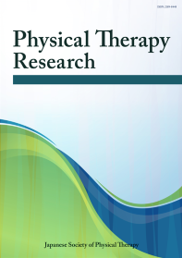Collections
Volume 26, Issue 3
Displaying 1-7 of 7 articles from this issue
- |<
- <
- 1
- >
- >|
Review
-
2023Volume 26Issue 3 Pages 71-77
Published: 2023
Released on J-STAGE: December 20, 2023
Advance online publication: November 18, 2023Download PDF (1310K) -
2023Volume 26Issue 3 Pages 78-88
Published: 2023
Released on J-STAGE: December 20, 2023
Advance online publication: November 25, 2023Download PDF (237K)
Original Article
-
2023Volume 26Issue 3 Pages 89-97
Published: 2023
Released on J-STAGE: December 20, 2023
Advance online publication: October 27, 2023Download PDF (7978K) -
2023Volume 26Issue 3 Pages 98-105
Published: 2023
Released on J-STAGE: December 20, 2023
Advance online publication: November 09, 2023Download PDF (353K)
Brief Report
-
2023Volume 26Issue 3 Pages 106-113
Published: 2023
Released on J-STAGE: December 20, 2023
Advance online publication: September 08, 2023Download PDF (1289K)
Physical Therapy Japan Vol.49 (2022) ABSTRACTS
-
2023Volume 26Issue 3 Pages 114-141
Published: 2023
Released on J-STAGE: December 20, 2023
Download PDF (983K)
Editorial Board
-
2023Volume 26Issue 3 Pages e3
Published: 2023
Released on J-STAGE: December 20, 2023
Download PDF (34K)
- |<
- <
- 1
- >
- >|
